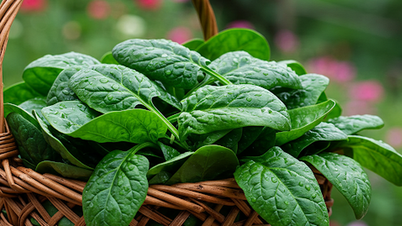On April 22, Bach Mai Hospital informed that doctors at the Poison Control Center had just received a 62-year-old female patient in Hanoi who suffered from kidney damage and acute kidney failure after believing in an online recommendation and picking wild plants growing in the garden to boil water to drink. The type of plant the woman drank was said to be purple tamarind.
According to the patient, because she saw people sharing online about the tamarind tree having cooling and detoxifying effects, and because her aunt often boiled it to drink to treat kidney stones and diabetes, and there were many trees growing in her garden, she pulled them out to use.
After cleaning the garden, the patient pulled up a large basket of about 0.5 kg, about the size of a bunch of water spinach. The patient took the white roots and bunches of tubers, some of which were as big as a little finger, washed them clean without any other plants to boil water to drink. Then, the tamarind was boiled until soft, concentrated from 1.5 liters of water to 600 ml, about 3 cups of drinking water.
The patient drank 2 cups and gave 1 cup to her 85-year-old mother to drink. The water tasted bitter, sour, and salty even though nothing was added to it. After drinking it for a short time, the patient felt uncomfortable, nauseous, and vomited fluid. The next morning, she woke up and went about her normal activities, but felt tired, had a headache, and was dizzy. After two days, she felt tired, lightheaded, and had no appetite, so she went to the hospital for a check-up.
At Bach Mai Hospital, doctors at the Poison Control Center said the patient was admitted conscious, without fever, weakness, nausea, or abdominal pain, and mainly complained of a dull headache. The patient's medical history was only a herniated disc, however, urine and blood tests showed that the creatine index was many times higher than normal, a sign of kidney damage and acute kidney failure.
According to the doctors at the Poison Control Center, the sample of the patient's item was sent to a specialist and identified as Oxalis corymbosa DC. The test results of the item (the sample of Oxalis corymbosa DC the patient drank) at the National Institute for Food Safety and Hygiene showed that it contained oxalic acid. This is the cause of kidney failure when the patient drinks too much.
Dr. Nguyen Trung Nguyen - Director of the Poison Control Center said that Oxalic Acid is considered an agent that causes kidney damage and kidney failure if ingested in large amounts. More severe cases will cause acute poisoning and can lead to death. The Center has received patients with oxalic acid poisoning and kidney failure due to direct ingestion of this chemical. However, this is the first case the Center has recorded a diagnosis of a patient who drank a plant containing oxalic acid and was poisoned with kidney failure.
“When searching the world's medical literature, we have not found any reports or studies recording people being poisoned by this plant,” Dr. Nguyen Trung Nguyen emphasized.
Doctor examines patient. (Photo: PV/Vietnam+)
According to Dr. Nguyen, oxalic acid (oxalate salt) is an organic acid with quite strong acidity, about 10,000 times stronger than acetic acid. Under normal conditions, oxalic acid exists in crystalline form, easily soluble in water to form a colorless solution with a sour taste. In high doses, oxalic acid easily irritates the intestinal mucosa and in pure doses with a content of 4-5g, it can cause acute poisoning, even leading to death.
The toxic dose (LD50) of pure oxalic acid is estimated at 378 mg/kg body weight (about 22.68 g/60 kg person). The combination of oxalic acid with calcium creates calcium oxalate, which can cause precipitation and deposition to form stones in the urinary organs, liver, gallbladder, pancreas... or accumulate in the joints.
Oxalic acid can be found in vegetables, tubers, and fruits that people consume every day such as star fruit, lemon, grapes, tamarind, beetroot, cocoa, spinach, tea leaves, bok choy, celery... The easy way to recognize when eating foods containing oxalic acid is that they have a sour, astringent taste. However, with normal daily eating of these foods, the amount of oxalic acid taken in does not affect health. Tamarind is famous for its oxalic acid content and perhaps more than other plants.
Doctor Nguyen analyzed that this is a typical case of a type of herb, even though it is recorded as being edible, but if eaten in excess it can also lead to poisoning. In addition, the issue of using herbs to treat diseases, although considered herbs, sounds benign, and some are even used as medicine, but as medicine, it is necessary to follow the principles of medical examination, treatment, drug management and drug use.
Therefore, Dr. Nguyen recommends that when people have health problems, they should go to the doctor to check and diagnose the disease, then prescribe and choose the appropriate type and dosage of medicine. People should absolutely not believe or follow information on the internet or word of mouth to avoid unfortunate consequences./.
(Vietnam+)
Source: https://www.vietnamplus.vn/nguoi-phu-nu-suy-than-cap-vi-uong-nuoc-me-dat-hoa-do-co-dac-post1034324.vnp



![[Photo] Prime Minister Pham Minh Chinh chairs conference on anti-smuggling, trade fraud, and counterfeit goods](https://vphoto.vietnam.vn/thumb/1200x675/vietnam/resource/IMAGE/2025/5/14/6cd67667e99e4248b7d4f587fd21e37c)

























































































Comment (0)